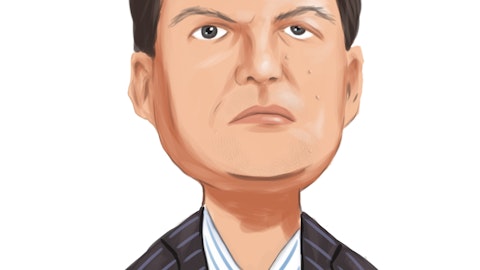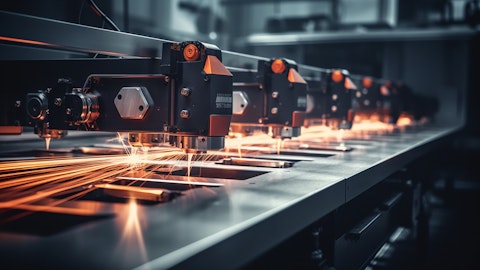We think that we will have always the best margin profile versus those that have to pretty much buy everything on the merchant market. So we are very active in many of these technologies that will be an advantage from a profitability standpoint.
Chuck Mattera: I would add, Simon — thank you, Giovanni. I would add, Simon, that we have a full portfolio of products that we’re making for today and developing for tomorrow. Those are going to be even more exciting than the ones we’re making today. And for us, having full control, as Giovanni just described, our focus is on time to market, time to volume and time to profitability and that’s where it needs to stay. We have a track record. It is a competitive market, that’s for sure. We’re intending to compete.
Simon Leopold: Thank you.
Operator: Thank you. One moment for our next question, please. Comes from the line of Jed Dorsheimer with William Blair. Please proceed.
Jed Dorsheimer: Hi. Thanks. Most questions seem to be on datacom so I’ll be different in just, I guess, two part question. Maybe just an update on the — I saw — I think it’s maybe the first time that I’ve seen you kind of highlight or call out. But on the MicroLED, could you just talk about the products of Coherent there that you’re offering? And then on silicon carbide, there’s been some cross currents of data points in the market. I’m just wondering if you might be able to update on — so what you’re seeing from the customer base there? Thanks.
Chuck Mattera: All right. Good morning, Jed. Thanks for your two questions. Chris will go first and then Sohail. Chris?
Christopher Dorman: Yeah. Thanks, Chuck. Yeah. So we spoke about the MicroLED developments that we have in previous quarters and about the multiple orders we received from China, Taiwan and Korea for the tools for a process called laser-induced forward transfer, which is where you take the currently 10 micron moving towards 5 micron MicroLEDs from the wafer to the display. So we’re seeing increasing customer engagement and are very excited about the impact of MicroLEDs on the television market. And this is a very high level of engagement now and a market that will be growing over the next three to five years.
Chuck Mattera: Thank you, Chris. Sohail?
Sohail Khan: Hello. Can you hear me?
Chuck Mattera: Yeah.
Sohail Khan: Thanks for your question. We are quite bullish about the silicon carbide market and the growth prospects over the next five to 10 years. And based upon that, we are sticking with our plan, which is driven from the customer engagement as well as long-term supply agreement which we had in place. The announcement with Mitsubishi and DENSO have strengthened our position, and we are seeing more engagements and especially a lot of interest from both existing and new customers for 200 millimeter. So we are going to stick to our plan of the investment and expansion, and we will continue to see the growth of our business quarter-over-quarter and year-over-year.
Jed Dorsheimer: Thank you.
Chuck Mattera: Thank you, Sohail. Thanks, Jed.
Operator: One moment for our next question, please. It comes from the line of Richard Shannon with Craig-Hallum Capital Group.
Richard Shannon: Hi, guys. Thanks for taking my question. Maybe I’ll ask a financial one here. It seems like after a couple of quarters of OpEx being flat to down, or I guess, a little bit more down on a pro forma basis, it seems like you’re implying it growing here at a fairly steady rate here, which seems to be antithetical to the synergy and restructuring plan, I think, you announced one or two quarters ago. Can you help us understand why that is, why it might seem to be growing at a decent rate after bottoming out here?
Chuck Mattera: Thanks a lot. Good morning, Richard. Rich will take it.
Richard Martucci: So yeah, as you pointed out, our synergy plans and cost reduction has kept our expenses down in the OpEx. The big thing that you see in the ramp up as we go forward in the guidance really is around R&D around our AI product, as well as other initiatives that we have in place. So that’s really the increase is coming from the R&D. We’ve done a really good job in our SG&A expenses.
Chuck Mattera: Look, those R&D investments in the second half of the year, Richard, are aimed for FY ’25 and beyond on the basis of new information that we’ve received in the last one or two quarters from our customers with great clarity.
Richard Shannon: Chuck, any way you’d want to characterize where those investments might sit, like by your segments or end markets or anything like that?
Chuck Mattera: In those markets that are growing extremely quickly, starting with AI, Richard. Everything starts with that.
Richard Shannon: Okay. Great. Thanks. Thanks for the detail.
Chuck Mattera: Thank you, Richard. Yeah.
Operator: Thank you. One moment for our next question. It comes from Karl Ackerman with BNP Paribas. Please proceed.
Karl Ackerman: Yes. Thank you. Good morning. As you indicated earlier on this call, VCSEL supply is critical right now on the ramp of both 800-gig and 1.6T transceivers. How has your internal capacity supported or helped your design wins for 1.6T, which you indicated will be ramping later on this year? And I guess if you could address that, perhaps could also discuss the ramp of 1.6T over the next couple of quarters. Thank you.
Chuck Mattera: Karl, thanks for your question. Giovanni will take it. And if there’s anything to add, that Julie would like to add to clarify, she will. Please, Giovanni.
Giovanni Barbarossa: Thanks for the question. I mean, as we said earlier, we have our own facility. Actually, we have two facilities, two, three fabs that are capable of producing datacom. But at this point in time, we’re relying on only one fab and it’s ramping like needed by our internal customers and external customers too, which are our competitors. So as we said earlier, we have — the advantage of being basically integrated to have a very a good understanding of the needs of the supply required by our — both internal and external customers. So we have a full control of that. And we have had similar ramps in the past this is a challenging ramp in terms of the data rate. But nevertheless, I think we are doing a great job in keeping up with the demand both internal and external supplies.
So at least we’re shipping based on demand. We are not behind even if we still need to go as requested by the forecast. So we are following up with the demand as we see it right now. So we don’t see that being a challenge at least for our VCSEL supply.
Chuck Mattera: Julie, would like to add regarding Karl’s question on 1.6T.
Julie Sheridan Eng: Right. Just to add to what Giovanni said is we also were one of the few in the industry actually that can make these very high speed. It’s a unique capability.
Chuck Mattera: Thanks. Thank you for your question, Kar.
Operator: Thank you. One moment for our next question, please. And it’s from Vivek Arya with Bank of America Securities. Please proceed.
Blake Friedman: Hi. This is Blake Friedman on for Vivek. Thanks for taking my question. On gross margin, you provided a useful outline on actions to return to 40%. But can you maybe quantify all the different takes ranging from improving utilization, operational efficiencies and new products? And this goes back to a previous question, but on mix, just given the momentum in AI transceivers, are these products at or above the corporate average gross margin today?
Chuck Mattera: Okay. Good morning, Blake. Thanks. Rich?
Richard Martucci: Yeah. So a two-part question. The first question is the AI. And I think in the last earnings call, we did mention that it is at the average of the — corporate average in terms of margin. In terms of our ability to drive margin in the future, obviously, the first thing is volume, that’s one. The second is utilization within our fabs, which really two of our six fabs have really improved in terms of the utilization and also the reliance of our synergy plan, the reliance of our restructuring plan is really going to be utmost of importance in terms of increasing our gross margin going forward.
Blake Friedman: Thank you.
Chuck Mattera: Thank you.
Operator: Thanks. One moment for our next question, please. It comes from the line of Christopher Rolland with Susquehanna. Please proceed.
Chuck Mattera: Good morning, Chris.
Christopher Rolland: Thanks for the question. Yeah. Can you hear me?



